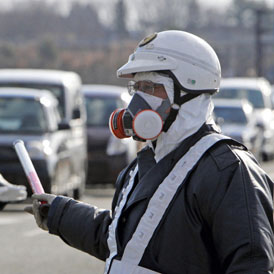Fukushima: a nuclear station in crisis
In a nation synonymous with the apocalyptic scenes in Hiroshima and Nagasaki the radioactive crisis at Japan’s Fukushima nuclear plant could become a defining moment for the nuclear industry.

The explosion and radioactive leak at Fukushima 1 Nuclear Power Plant, which followed Friday’s earthquake and tsunami, threatens to become the world’s worst atomic disaster since the Chernobyl disaster of 1986.
It could have serious consequences for the nuclear industry which has enjoyed a renaissance since the Three Mile Island accident of 1979 and the Chernobyl disaster of the 1980s.
TV footage of Fukushima shows a white cloud rising above the plant after an explosion.
There are concerns that a substantial radioactive release in Japan could lead to a dust cloud dispersal of radioactive materials being picked up by the Pacific jet stream and travelling onwards to the Western Seaboard of the United States.
The 8.9-magnitude earthquake triggered a series of events at two Tokyo Electric Power Company plants (TEPCO) that led to conditions for the radioactive leak because there was no electrical power to circulate vital cooling water over the superheated uranium fuel rods.
The electric plants at Daiichi and Daini are some 40-miles from the epicentre of the earthquake.
The nuclear industry has long maintained that nuclear reactors are immune from the effects of natural disasters but then came the announcement from the Tokyo Electric Company that it had lost the ability to control pressure at several reactors and that it was struggling with a valve that would allow the reactor pressures to be relieved.
A major evacuation was activated and an exclusion zone has been thrown up around the Fukushima plants with police roadblocks stopping people from entering the zone from up to 60-kilometers away. The plant is about 150-miles 240 km north of Tokyo.
“An unchecked rise in temperature could cause the core to essentially turn into a molten mass that could burn through the reactor vessel,” risk information service Stratfor said in a report before the explosion. “This may lead to a release of an unchecked amount of radiation into the containment building that surrounds the reactor.”
Mark Hibbs, a nuclear expert at the Carnegie Endowment for International Peace, said: “It is serious and it could lead to a meltdown. And what we’re seeing, barring any information from the Japanese that they have it under control, is that we’re headed in that direction.”
It is serious and it could lead to a meltdown. Mark Hibbs, nuclear expert
But Sue Ion, former chief technology officer at British Nuclear Fuels said that a major radioactive disaster was not likely: “I wouldn’t expect there to be a radiation emergency ultimately, they may have something to fix but it’s a precaution more than anything else.”
Industry experts said the precautions taken at Fukushima showed that enhanced security at nuclear power plants should prevent any disaster. But green groups said the threatened leak showed that the risks were still too high.
Altogether, some 11 Japanese reactors shut down after the earthquake and tsunami.
Environmental groups said the threat of a radiation leak underlines the risks from atomic energy.
Greenpeace’s Sven Teske said: “We’ve opposed nuclear power for decades, and this is another proof that it can’t be safe.”
A leading US scientist group said the incident highlighted the grave risk of inadequate back-up power to cooling systems at U.S. facilities.
New interest from governments and investors in nuclear power follows the development of more advanced plants, and a new focus on security of energy supply and moves to reduce carbon emissions.
Nuclear plants generate low-carbon power in contrast to fossil fuels and can produce constantly unlike wind and some other clean energy sources.
The Vienna-based International Atomic Energy Agency (IAEA) estimated last month that about 10 countries have decided to introduce nuclear power and started preparatory infrastructure work, up from four in 2008.